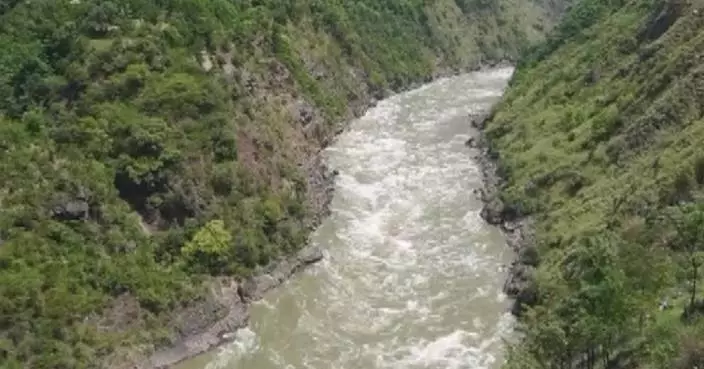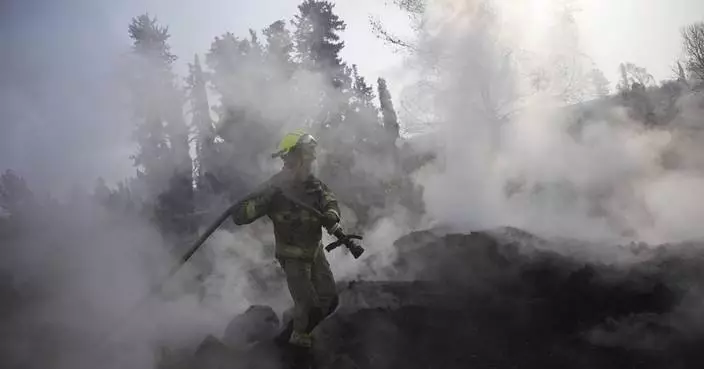Biologists have observed Bryde's whales preying on fish with unique foraging patterns in waters near south China's Weizhou Island, using creative teamwork to trap their harvest near the ocean surface.
The foraging techniques were discovered by Chinese and Thailand biologists, who have been working closely to protect Bryde's whales, one of the national first-class protected aquatic animals in China.
Weizhou Island, located in the Beibu Gulf, is China's youngest volcanic island. Bryde's whales, a species mainly living in tropical and subtropical waters, are frequently spotted preying on fish in the waters near Weizhou Island.
Patcharaporn Yaowasooth, a marine biologist at the Department of Marine and Coastal Resources of Thailand, said that during her joint research with the Chinese partners, she discovered a great number of similarities in the ways that Bryde's whales in Thailand and China hunt. This includes corkscrew-style swimming and bubble-net feeding -- a learned method of cooperative hunting in which a group of whales traps fish within a net of bubbles formed by exhaling through their blow holes.
"Almost all of them in Thailand have this feeding. And (the similarities extend) up to the species and fish that they eat, also," she said.
Yet, the scientists also saw unique behaviors that are not seen in Thai waters, as a Chinese professor from the School of Life Sciences of Nanjing Normal University explained.
"The Bryde's whale living in the waters near Weizhou Island have two unique foraging behaviors. In one case, they were discovered emerge from the water, tilt to the right, and then whirl around in a full or half circle, just like one creates swirling motion while scooping. We named the new hunting technique as 'self-rotating foraging' or 'swirling foraging'. In another case, they conduct teamwork, making up a circle with their bodies and then spiraling up to the water surface to trap the fish inside before eating up the harvest. This is a quite unique foraging technique," said Bingyao Chen, a professor at the university's School of Life Sciences.
Bryde's whales, like other species, are capable of learning non-instinctual behaviors from each other, allowing unique behaviors to develop in different parts of the oceans.

Chinese, Thai biologists discover unique foraging pattern of Bryde's whale
U.S. tariffs on Cambodia, which were set at 49 percent, have sparked concerns among the Southeast Asian country's key export industries such as garment manufacturing amid the ensuing economic uncertainties.
On April 2, U.S. President Donald Trump announced the 49 percent "reciprocal tariff" on goods imported from Cambodia, the highest among all countries. Days later, the U.S. reduced the so-called "reciprocal tariff" to 10 percent for 90 days, offering a window period to Cambodia for negotiations with it.
Cambodian businesspeople say the tariffs have the potential to wreak havoc on the country's manufacturing sector, which, according to data from the World Bank, makes up around a fifth of the country's GDP.
"For U.S. manufacturers, definitely, there will be a big impact. If manufacturers are focusing on U.S. products, they are now in the middle. They don't know what they should do at the moment because the tariff now from Cambodia to the U.S. is actually quite high," said Dr. Ben Li, a Hong Kong investor in Cambodia and Chairman of the Cambodia Chinese Commerce Association.
Nevertheless, Li sees the tariff hike as an opportunity to export more Cambodian goods to the European Union, where a majority of Cambodian exports enjoy duty-free status.
"I always say there will be a light (at the end of the tunnel.) Even now, the U.S. tariff is so high, it's going to be so high after 90 days, we don't know. But, there's still a big market to Japan or to the European Union. There's still a big opportunity there," he said.
The Cambodian investor also believes the development of major infrastructure projects will help support Cambodia's economy.
"Especially the new canal and then the new airport, and the railways which connect to China. I believe once the logistics and infrastructure are built up, it can help the whole country's economy. By reducing the transportation costs, it can also mitigate the tariff costs," he said.
Cambodia and the U.S. held their first tariff negotiations on April 16, with more expected to follow. Local experts said the stakes are high for the country's workers.
"If this negotiation fails, there will be a significant impact. It will include the garment and travel goods sector. These sectors consist of about 1,068 factories and 930,000 workers. The income generated from these sectors is about 3 billion dollars per year. So it would significantly impact Cambodia's economy, jobs and incomes," said Chey Tech, a socio-economic research and development consultant from Dynamic Alliance Consulting.
Despite the potential risks, Tech expressed his optimism about a positive outcome, citing Cambodian Prime Minister Hun Manat's letter to Trump on April 4.
"The Prime Minister's letter confirmed that Cambodia would reduce the tariff rate for U.S. goods to 5 percent. Second, Cambodia is the least developed country. Third, Cambodia produces goods that the developed countries won't produce. We asked whether the U.S. would be able to produce these low-cost products. It cannot," said Tech.
In 2024, Cambodia exported goods of 9.9 billion dollars to the U.S., making it the country's largest market, accounting for 37 percent of Cambodia's total exports.

49-percent US tariffs sparks worry among Cambodia's key export industries





















































